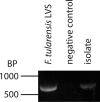The potential for flower nectar to allow mosquito to mosquito transmission of Francisella tularensis
- PMID: 28486521
- PMCID: PMC5423603
- DOI: 10.1371/journal.pone.0175157
The potential for flower nectar to allow mosquito to mosquito transmission of Francisella tularensis
Abstract
Francisella tularensis is disseminated in nature by biting arthropods such as mosquitoes. The relationship between mosquitoes and F. tularensis in nature is highly ambiguous, due in part to the fact that mosquitoes have caused significant tularemia outbreaks despite being classified as a mechanical vector of F. tularensis. One possible explanation for mosquitoes being a prominent, yet mechanical vector is that these insects feed on flower nectar between blood meals, allowing for transmission of F. tularensis between mosquitoes. Here, we aimed to assess whether F. tularensis could survive in flower nectar. Moreover, we examined if mosquitoes could interact with or ingest and transmit F. tularensis from one source of nectar to another. F. tularensis exhibited robust survivability in flower nectar with concentrations of viable bacteria remaining consistent with the rich growth medium. Furthermore, F. tularensis was able to survive (albeit to a lesser extent) in 30% sucrose (a nectar surrogate) over a period of time consistent with that of a typical flower bloom. Although we observed diminished bacterial survival in the nectar surrogate, mosquitoes that fed on this material became colonized with F. tularensis. Finally, colonized mosquitoes were capable of transferring F. tularensis to a sterile nectar surrogate. These data suggest that flower nectar may be capable of serving as a temporary source of F. tularensis that could contribute to the amplification of outbreaks. Mosquitoes that feed on an infected mammalian host and subsequently feed on flower nectar could deposit some F. tularensis bacteria into the nectar in the process. Mosquitoes subsequently feeding on this nectar source could potentially become colonized by F. tularensis. Thus, the possibility exists that flower nectar may allow for vector-vector transmission of F. tularensis.
Conflict of interest statement
Figures




Similar articles
-
Detection of Francisella tularensis in Alaskan mosquitoes (Diptera: Culicidae) and assessment of a laboratory model for transmission.J Med Entomol. 2010 Jul;47(4):639-48. doi: 10.1603/me09192. J Med Entomol. 2010. PMID: 20695280 Free PMC article.
-
Transstadial transmission of Francisella tularensis holarctica in mosquitoes, Sweden.Emerg Infect Dis. 2011 May;17(5):794-9. doi: 10.3201/eid1705.100426. Emerg Infect Dis. 2011. PMID: 21529386 Free PMC article.
-
Transmission of tularemia from a water source by transstadial maintenance in a mosquito vector.Sci Rep. 2015 Jan 22;5:7793. doi: 10.1038/srep07793. Sci Rep. 2015. PMID: 25609657 Free PMC article.
-
Water and mosquitoes as key components of the infective cycle of Francisella tularensis in Europe: a review.Crit Rev Microbiol. 2024 Sep;50(5):922-936. doi: 10.1080/1040841X.2024.2319040. Epub 2024 Feb 23. Crit Rev Microbiol. 2024. PMID: 38393764 Review.
-
Ecology of Francisella tularensis.Annu Rev Entomol. 2020 Jan 7;65:351-372. doi: 10.1146/annurev-ento-011019-025134. Epub 2019 Oct 10. Annu Rev Entomol. 2020. PMID: 31600457 Free PMC article. Review.
Cited by
-
The European Union One Health 2022 Zoonoses Report.EFSA J. 2023 Dec 12;21(12):e8442. doi: 10.2903/j.efsa.2023.8442. eCollection 2023 Dec. EFSA J. 2023. PMID: 38089471 Free PMC article.
-
Tularemia as a Mosquito-Borne Disease.Microorganisms. 2020 Dec 23;9(1):26. doi: 10.3390/microorganisms9010026. Microorganisms. 2020. PMID: 33374861 Free PMC article. Review.
-
The food of life: which nectar do mosquitoes feed on?-An evidence-based meta-analysis.Environ Entomol. 2025 Apr 17;54(2):352-366. doi: 10.1093/ee/nvaf009. Environ Entomol. 2025. PMID: 39899382 Free PMC article.
-
Development of Immunoassays for Detection of Francisella tularensis Lipopolysaccharide in Tularemia Patient Samples.Pathogens. 2021 Jul 22;10(8):924. doi: 10.3390/pathogens10080924. Pathogens. 2021. PMID: 34451388 Free PMC article.
-
The European Union One Health 2021 Zoonoses Report.EFSA J. 2022 Dec 13;20(12):e07666. doi: 10.2903/j.efsa.2022.7666. eCollection 2022 Dec. EFSA J. 2022. PMID: 36524203 Free PMC article.
References
-
- Santic M, Akimana C, Asare R, Kouokam JC, Atay S, Kwaik YA. Intracellular fate of Francisella tularensis within arthropod-derived cells. Environ Microbiol. 2009;11(6):1473–81. Epub 2009/02/18. doi: 10.1111/j.1462-2920.2009.01875.x - DOI - PubMed
-
- Petersen JM, Mead PS, Schriefer ME. Francisella tularensis: an arthropod-borne pathogen. Vet Res. 2009;40(2):7 Epub 2008/10/28. PubMed Central PMCID: PMC2695023. doi: 10.1051/vetres:2008045 - DOI - PMC - PubMed
-
- Akimana C, Kwaik YA. Francisella-arthropod vector interaction and its role in patho-adaptation to infect mammals. Front Microbiol. 2011; 2:34 Epub 2011/06/21. PubMed Central PMCID: PMC3109307. doi: 10.3389/fmicb.2011.00034 - DOI - PMC - PubMed
-
- Asare R, Akimana C, Jones S, Abu Kwaik Y. Molecular bases of proliferation of Francisella tularensis in arthropod vectors. Environ Microbiol. 2010;12(9):2587–612. Epub 2010/05/21. PubMed Central PMCID: PMC2957557. doi: 10.1111/j.1462-2920.2010.02230.x - DOI - PMC - PubMed
-
- Hubalek Z, Halouzka J. Mosquitoes (Diptera: Culicidae), in contrast to ticks (Acari: Ixodidae), do not carry Francisella tularensis in a natural focus of tularemia in the Czech Republic. J Med Entomol. 1997;34(6):660–3. Epub 1998/01/24. - PubMed
MeSH terms
Substances
Grants and funding
LinkOut - more resources
Full Text Sources
Other Literature Sources

